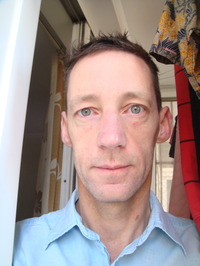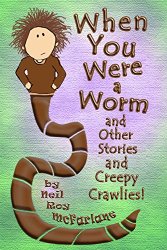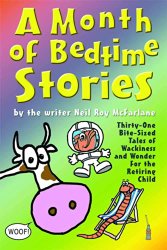Meet Children’s Book Author Neil McFarlane
 Neil Roy McFarlane is from the UK. He lived in Asia for over ten years and speaks passable Chinese. He writes in his spare time.
Neil Roy McFarlane is from the UK. He lived in Asia for over ten years and speaks passable Chinese. He writes in his spare time.
Tell us about your latest published children’s book. Who do you think should read it? What are you most proud of?
 When You Were a Worm is a collection of short stories written in the second person (as is my previous book A Month of Bedtime Stories). Both books are aimed at parents who enjoy reading to/with their children. In each story of When You Were a Worm, ‘you’ (i.e. the listening child) change into an animal and embark on a rather silly and fantastical adventure. For example, in one story you change into a flea and become the star performer in Professor Heckler’s World Famous Flea Circus; in another you change into a caterpillar and go back in time to teach prehistoric caterpillars how to change into butterflies. As to what I’m most proud of, the question tempts me to be serious and claim it’s educational – the kids are going to learn some zoology and get an insight into the lives of these creatures. It’s true that was something I kept in mind when I wrote the stories, but I have to admit that was secondary. What I really wanted to do was entertain and delight.
When You Were a Worm is a collection of short stories written in the second person (as is my previous book A Month of Bedtime Stories). Both books are aimed at parents who enjoy reading to/with their children. In each story of When You Were a Worm, ‘you’ (i.e. the listening child) change into an animal and embark on a rather silly and fantastical adventure. For example, in one story you change into a flea and become the star performer in Professor Heckler’s World Famous Flea Circus; in another you change into a caterpillar and go back in time to teach prehistoric caterpillars how to change into butterflies. As to what I’m most proud of, the question tempts me to be serious and claim it’s educational – the kids are going to learn some zoology and get an insight into the lives of these creatures. It’s true that was something I kept in mind when I wrote the stories, but I have to admit that was secondary. What I really wanted to do was entertain and delight.
Thinking back to your own childhood, is there a particular author or illustrator who was a favourite? Why do you suppose that person’s work resonated with you?
I graduated through three authors as my childhood progressed: Enid Blyton (The Faraway Tree series), Tolkien (Lord of the Rings), and Ray Bradbury (The Illustrated Man). The Faraway Tree series and The Illustrated Man (and the Narnia series which I also loved) all involve traveling through a magic portal into other worlds. Lord of the Rings just was another world, no portal required. The common thread – of fantasy and escapism – is obvious, but I’m not sure why I was so desperate to escape. Maybe my childhood was worse than I remember it, but I think I just enjoyed such wild flights of imagination.
Was it difficult for you to get your first book published? What suggestions/words of encouragement do you have for aspiring authors/illustrators?
Hmmm. Well, I don’t consider myself as having been published. I have signed a deal with a ‘proper’ publisher, but the book (a language learning textbook) isn’t finished yet. So far, with these storybooks, I’m ‘only’ self-published and have sold very few copies to boot. At which point some people might wonder: “Why are they interviewing this nobody?” Well, maybe I’ll end up becoming the new Dickens, but if on the other (more likely) hand I remain rather obscure and unknown, it still wouldn’t be a great tragedy for me personally, because writing is something I love to do. Fame or obscurity, I just really enjoy the experience of writing and being creative. So in terms of offering encouragement to other aspiring writers, I’d just say: do it if you love it.
When did you realize that you would be a writer/illustrator? Is there a particular person who has inspired and/or supported your work along the way?
I realized I wanted to be a writer when I was about 8 years old. I just fell in love with reading and thereby living in other worlds. It was a way to have a(n admittedly one-sided) conversation with the greatest minds both living and dead. I admired writers more than anyone. I quickly realized that when I was watching a movie, the actor was just mouthing the words, and the director was just directing the story, that the writer had written. The writer was the great puppeteer who pulled the strings. It’s kind of like being God. An engineer can make a vacuum cleaner; a builder can make a house; but as a writer, you can make a whole world. Wow wow wow!
If we were watching over your shoulder as you work on a book, what would we see? Where do you work? What does your writing / illustrating process look like?
With A Month of Bedtime Stories, I would usually wake at 5am on weekdays to write for a couple of hours before going to work. Then I would write some more on the train to and from work, usually on scraps of paper, sometimes even on train tickets and till receipts if I’d run out of paper. Then at weekends I’d go out walking on the coast path and have more ideas and stop to jot them down on more scraps of paper. Everything would then be typed out at night. Writing this way, it took me two months to complete at the rate of about one story every two days or so. If you were to look at all those bits of paper, it would be pretty indecipherable owing to my terrible handwriting, edits, deletions, insertions, and a multitude of geometric symbols which would be meaningless to anyone but me.
I thought the title A Month of Bedtime Stories was catchy, but really thirty-one stories was a bit ambitious. The hardest part was clawing my way across the finish line without losing focus or feeling my standards were slipping.
Tell us about your experiences sharing your book with children. Has anything unusual / endearing / funny / unexpected happened?
The first person to read A Month of Bedtime Stories was a lady at work. The next day after reading the first couple of stories to her 7-year-old daughter, she came up to me at work and proceeded to tell me about how much they both enjoyed it. It was such a big effort writing that book and therefore such a relief to know it wasn’t all some vain exercise in self-delusion, that tears welled up in my eyes. So I was trying to turn away and pretend to scratch my cheek to wipe away a tear without her noticing. It was kind of embarrassing. I am British, after all. (Stiff upper lip and all that jazz.)
Does music play a part in your writing/illustrating? If so, what sort of music do you connect with your work?
Several characters sing songs in A Month of Bedtime Stories. At one point a red Indian hedgehog sings this song while communing with the spirit world to discover a way to steal caster sugar from a herd of evil deer witches:
Ho yay hicky yicky
Ho yay hakka chakka
Yanna wanna holy no
Hi yay ho yay
Hicky chicky cha cha
Yanna wanna ha ha
A-tishoo a-tishoo
We all fall down!
And in another story, a platoon of marching crabs, who act like a kind of Greek chorus presaging the events to come, sing this song:
Yo ho ho and a bucket of suds
Ethel wait no baby go slow mo
Ring-a-ding nocerouse, sparrow, bee, eek-a-mouse
Chop like a chop chop, crow like a crow!
And in another story an old lady called Mrs Teasel has a finger which sings a magic song, but I can’t reveal the lyrics because it would be a total plot spoiler.








































